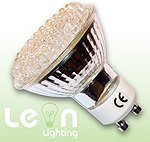Go Green and Cool with LED downlighters
Tuesday, 15th September 2009
 Many home owners opt for halogen downlighters in their loft conversion and with good reason. Downlighters look modern and as the ceiling
is often lower than normal in a loft conversion you dont have the problem of banging your head into the lights. Halogen bulbs give off
a nice bright and warm light, they also work well with dimmer switches and replacement bulbs are relatively cheap. But there is a slight
down side to halogen downlighters, they are power hungry and can get very hot. Just lately we've noticed that LED replacements bulbs for
GU10 and MR16 halogen bulbs are becoming more common, but are they any good?
Many home owners opt for halogen downlighters in their loft conversion and with good reason. Downlighters look modern and as the ceiling
is often lower than normal in a loft conversion you dont have the problem of banging your head into the lights. Halogen bulbs give off
a nice bright and warm light, they also work well with dimmer switches and replacement bulbs are relatively cheap. But there is a slight
down side to halogen downlighters, they are power hungry and can get very hot. Just lately we've noticed that LED replacements bulbs for
GU10 and MR16 halogen bulbs are becoming more common, but are they any good?
Ease of use
To keep things simple I'm only going to be talking about GU10 and MR16 type bulbs in this post. If you don't know what they are then don't worry, they are the most common type of halogen bulb in downlighters. GU10 bulbs run from 240v and MR16 bulbs run from 12v supplied by a transformer. So how easy is it to change over to LED bulbs? The answer is that its extremely easy, in fact its as easy as, well, changing a light bulb. Just take out one of your existing bulbs (make sure its not hot!) take a look to see what type it is, buy led replacements and pop them in - easy!
Cost and Energy Saving
The engery savings to made with LED bulbs is exceptional, LED bulbs consume somewhere between 1 and 5 watts of power compared to 30 to 50 watts for a standard GU10 bulb. The downside is the initial purchase price of the bulbs, currently a good quality LED bulb will set you back up to £20 compared with around £2 for a halogen GU10 - thats up to ten times the price! Most led bulbs are rated to last around 50,000 hours which equates to a ten year lifespan so there may also be some savings on replacement bulbs as well.
Light Quality
This where things start to get confusing, LED bulbs tend to give a slightly blue light where a halogen bulb tends to be yellow. Most people prefer the warmer light of a halogen bulb so LED manufacturers have been working to create bulbs that give a more natural light. The colour temperature (measured in Kelvin) is used to describe the hue of light that a bulb will give:
- 2700K - Warm white, has more yellow/orange hues
- 3000K - Halogen white, clear white light, best for indoor use
- 4100K - Cool white, a slight hint of blue
- 5000K - Bright but with a hint of blue, good for display cabinets
- 5600K - Brighter but with blue tinge, best for outdoor use
Most halogen bulbs are rated at 3000K, so if you like a warmer light then try to get as close to 3000k as you can.
Brightness
You may see LED bulbs rated by the amount of light they give off, this is measured in lumens. The problem is that most consumers are used to buying bulbs rated by the wattage and are confused by lumens. Fortunately many retailers and manufacturers have realised this and often compare the bulbs out to that of a halogen bulb. Check the output of the bulbs before purchasing, any good retailer will be able to advise if you are unsure.
Mercury and Dimming
LED bulbs contain no mercury which is great and they are quite robust and unlikely to break or smash. One of the biggest drawbacks of current LED lights is that most of them do not work with dimmer switches. Not so much a problem in kitchens where you want the lights on full all the time but in bedrooms and living rooms its nice to be able to dimm the lights.
Conclusion
I think that providing you buy the right colour temperature bulbs for the application then LED bulbs are the way to go. The price of electricity is likely to go up in the future and the government has set challenging targets to reduce our CO2 emissions to help prevent climate change. So while there are some downsides, overall it seems to make sense to make the switch to LED bulbs.